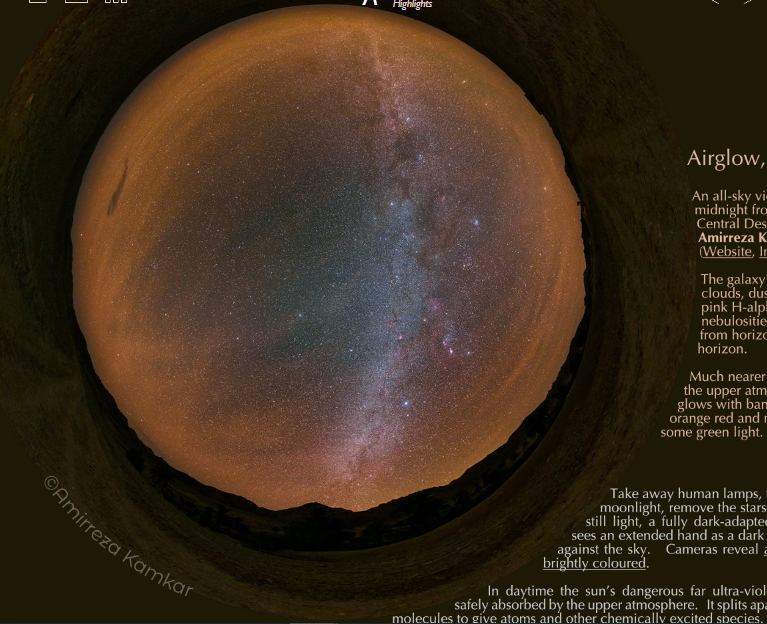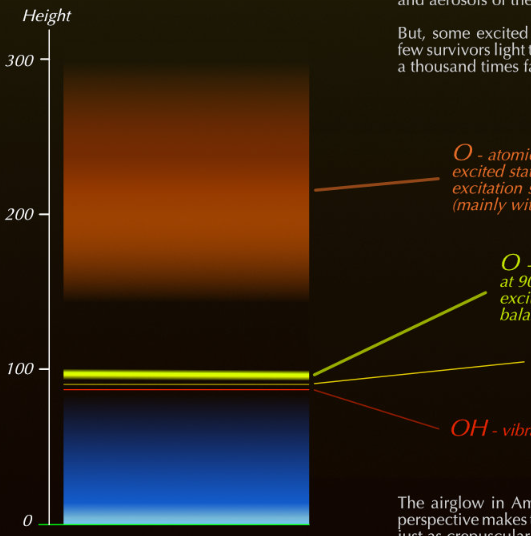Airglow, Iran
Airglow: Illuminating the Night Sky in Iran
Have you ever looked up at the night sky and marveled at its beauty? The stars, the moon, and the vast expanse of space all create a sense of wonder and awe. But did you know that even when the stars are hidden, there is still light illuminating the sky? This phenomenon is known as airglow, and it can be seen in various parts of the world, including Iran's Central Desert.
The Hidden Glow of the Upper Atmosphere
When we remove human lamps, moonlight, and even the stars from the equation, we can still perceive a faint glow in the sky. With a fully dark-adapted eye, this glow appears as bands of orange-red and sometimes green light. However, it is through the lens of a camera that the true colors of airglow are revealed in all their vibrant glory.
Unveiling the Science Behind Airglow
During the daytime, the sun emits far-ultraviolet light that is safely absorbed by the upper atmosphere. This interaction causes oxygen molecules to split apart and create chemically excited species. Through direct and chemiluminescent reactions, these excited species radiate energy and produce bright airglow. Unfortunately, this glow is invisible against the blinding sunlight and scattering caused by the molecules and aerosols in the denser troposphere below.
The Nighttime Glow
As sunset approaches, some excited atoms and molecules manage to survive and continue emitting light. These survivors become the source of the night sky's glow, which is fortunate for astronomers as it is approximately a thousand times fainter than daylight airglow. Different elements contribute to this nighttime glow, including atomic oxygen (O), sodium (Na), and vibrationally and rotationally excited OH radicals.
Airglow's Spectral Signature
In the captivating image captured by Amirreza Kamkar, the airglow in Iran's Central Desert is showcased in all its branded beauty. The bands of airglow appear parallel, but due to perspective, they seem to converge at opposite points on the horizon, similar to crepuscular rays or railway tracks. This branding effect is caused by slow-moving waves in the upper atmosphere that influence chemical reactions and the deactivation of excited states responsible for the airglow emission.
Exploring the Different Components of Airglow
Let's delve deeper into the specific components of airglow:
-
O Atomic Oxygen Emission: This emission originates from excited atomic oxygen with a remarkably long half-life of 110 seconds. The rarity of deactivating collisions, primarily with N2 molecules, allows the excited state to persist for such an extended period at heights where it occurs.
-
O Atomic Oxygen: Among the various components of airglow, atomic oxygen is usually the brightest at altitudes ranging from 90 to 100 kilometers. Although collisional deactivation is more prevalent at these heights, the shorter lifetime of the excited state, approximately 1 second, balances this out.
-
Na Sodium Light: A thin layer of sodium light also contributes to airglow, with the sodium primarily thought to originate from meteors.
-
OH Radicals: Finally, vibrationally and rotationally excited OH radicals add their unique touch to the airglow phenomenon.
Captivating Green Atomic Oxygen Airglow
In a stunning image captured from above by NASA's Earth Observatory, we can witness the captivating green glow of atomic oxygen in the upper atmosphere. This image provides a breathtaking perspective on the vastness and beauty of airglow, showcasing its intricate patterns and colors.
Airglow is a captivating natural phenomenon that adds an extra layer of beauty to our nighttime skies. Whether it's the vibrant colors of atomic oxygen or the subtle glow of excited atoms and molecules, airglow reminds us of the complex interactions occurring in our atmosphere. So, the next time you find yourself gazing up at the night sky, take a moment to appreciate the hidden wonders of airglow and the mysteries it holds.

Airglow, Iran
An all-sky view near midnight from Iran's Central Desert by Amirreza Kamkar (Website, Instagram).
The galaxy's star clouds, dust, and pink H-alpha nebulosities stretch from horizon to horizon.
Much nearer to home, the upper atmosphere glows with bands of orange red and maybe some green light.
Take away human lamps, take away moonlight, remove the stars. There is still light, a fully dark-adapted eye just sees an extended hand as a dark silhouette against the sky. Cameras reveal airglow as brightly coloured.
In daytime the sun's dangerous far ultra-violet light is safely absorbed by the upper atmosphere. It splits apart oxygen molecules to give atmos and other chemically excited species. They by direct and chemiluminescent reactions radite their energy creating bright airglow. It's invisible against blinding sunlight and scattering by the molecules and aerosols of the denser air of the troposphere far below.
But, some excited atoms and molecules are overtaken by sunset. These few survivors light the night sky. Their glow is, fortunately for astronomers, a thousand times fainter.

O - atmonic oxygen emission. The atoms radiate from an excited state with a colossal half life of 110 seconds. The excitation survives so long because deactivating collisions (mainly with N2) are rare at these heights.
O - atomic oxygen. Usually the brightest airglow at 90-100 km height. Collisional deactivation of the excited atoms is fiercer at these altitudes but this is balanced by the excited state's shorter lifetime of 1s.
Na - a thin layer of sodium light. The sodium is though to come mainly from meteors.
OH - vibrationally and rotationally excited OH radicals.
The airglow in Amirreza's image is branded. The bands are parallel but perspective makes them appear to converge at opposite points on the horizon just as crepuscular rays and railway tracks do.
Branding is caused by slow moving waves in the upper atmosphere. Their slight oscillations in pressure and temperature influence rates of chemical reactions and collisional deactivation of the excited states that produce the emission.

Green atomic oxygen airglow from above.
Credit: NASA Earth Observatory
Note: this article has been automatically converted from the old site and may not appear as intended. You can find the original article here.
Reference Atmospheric Optics
If you use any of the definitions, information, or data presented on Atmospheric Optics, please copy the link or reference below to properly credit us as the reference source. Thank you!
-
<a href="https://atoptics.co.uk/blog/airglow-iran/">Airglow, Iran</a>
-
"Airglow, Iran". Atmospheric Optics. Accessed on April 26, 2024. https://atoptics.co.uk/blog/airglow-iran/.
-
"Airglow, Iran". Atmospheric Optics, https://atoptics.co.uk/blog/airglow-iran/. Accessed 26 April, 2024
-
Airglow, Iran. Atmospheric Optics. Retrieved from https://atoptics.co.uk/blog/airglow-iran/.